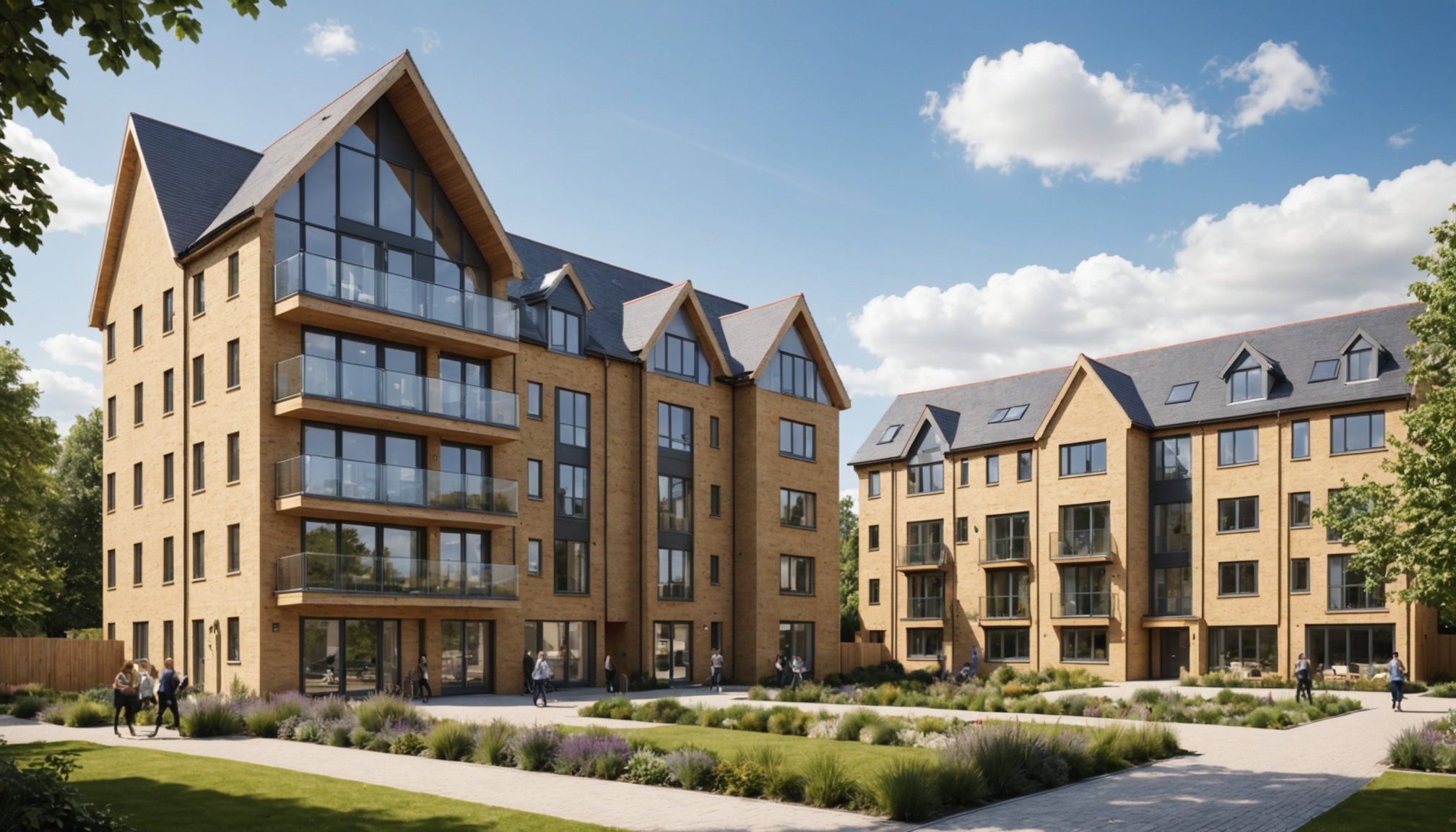Unveiling Sustainable Practices in New UK Property Developments: A Comprehensive Exploration
As the UK grapples with its ongoing housing crisis, the government has introduced ambitious planning reforms aimed at delivering 1.5 million new homes over the next five years. However, this rapid development must be balanced with the urgent need to protect the environment and promote sustainability. Here, we delve into the sustainable practices that are shaping the future of UK property developments.
The Need for Sustainable Development
The UK’s housing crisis is well-documented, but the solution cannot come at the expense of the environment. The construction sector is a significant contributor to carbon emissions, resource depletion, and waste generation. To mitigate these impacts, the integration of circular economy (CE) principles into the planning, design, and construction of new homes is crucial.
Also to read : Uncovering the risks: navigating the financial challenges of investing in uk agricultural land for non-agricultural purposes
“The construction sector is notorious for its significant environmental impact, including high carbon emissions, resource depletion, and waste generation. Now, more than ever, it’s crucial to integrate circular economy practices into the planning, design, and construction of new homes,” notes Leonie Dunn in a recent UCL blog post[1].
What is the Circular Economy and Why Does It Matter?
The circular economy is a regenerative system where materials are kept at a higher value for longer through processes like reuse, recycling, maintenance, and refurbishment, rather than following the traditional “take, make, dispose” approach. In the context of construction, this means using recycled building materials, refurbishing existing buildings, and designing homes to be adaptable and reusable at the end of their lifecycle.
Also to see : Unlocking etf opportunities: a smart investment guide for belgium
Here are some key ways the circular economy can be applied in new developments:
- Using Recycled Materials: Encouraging the use of recycled materials in construction can significantly reduce the demand for new resources and lower carbon emissions.
- Refurbishing Existing Buildings: With over 600,000 empty homes recorded in England, refurbishing and retrofitting unused buildings can save valuable materials, reduce embodied carbon, and lessen waste[1].
- Adaptable Building Designs: Designing homes with “end of life” in mind ensures they can be reused, repurposed, or recycled, reducing the environmental burden for future generations.
Protecting and Enhancing Biodiversity
The UK is one of the most nature-depleted countries globally, and the new housing targets risk further disrupting ecosystems and natural landscapes. To avoid this, sustainable planning must prioritize protecting valuable green spaces and incorporating green infrastructure into developments.
Green Infrastructure and Modern Methods of Construction
- Green Infrastructure: Incorporating parks, trees, and green roofs into developments helps maintain biodiversity and enhances the natural environment.
- Modern Methods of Construction (MMC): MMC involves off-site manufacturing of building components, which can then be rapidly assembled on-site. This approach reduces waste, lowers carbon emissions, and minimizes local disruptions to surrounding habitats[1].
Achieving Growth Without Compromising the Environment
The UK Government’s planning reforms present a unique opportunity to address both the housing crisis and environmental sustainability. Here are some strategies to achieve this balance:
Maximizing the Use of Existing Resources
- Pre-Development Audits: Making pre-development audits mandatory can help assess the potential for reusing buildings or materials, reducing costs and conserving resources.
- Eco-Design Solutions: Using lean structural elements, lighter-weight materials, and adaptable building layouts can reduce the environmental footprint of construction projects[1].
Incentivizing Sustainability
- Recycled Materials Markets: Investing in and developing secondary material markets can encourage the use of recycled materials by creating clear standards for safety and quality[1].
- Nature Market Initiatives: Projects like the Blackwater Environmental Investment for Conservation (BEIC) and the DIME 2 initiative are creating attractive investment propositions for developers and businesses, focusing on Biodiversity Net Gain (BNG), blue carbon, and water quality improvements[4].
Policy and Planning Frameworks
The National Planning Policy Framework (NPPF) provides a crucial framework for sustainable development. Here are some key aspects:
Sustainable Development Principles
- Sustainable Transport: Promoting sustainable transport options and high-quality communications to reduce the carbon footprint of new developments[3].
- Effective Use of Land: Making effective use of land to ensure that development is sustainable and does not harm the natural environment[3].
- Climate Change Mitigation: Plans must reflect measures to address climate change mitigation and adaptation, including the conservation and enhancement of the natural environment[3].
Affordable Housing and Green Belt Protection
- Affordable Housing: Ensuring that at least 50% of new housing is affordable, unless this would make the development unviable[3].
- Green Belt Protection: Strategic policies must protect Green Belt land and ensure that any development within or released from the Green Belt is sustainable and does not harm biodiversity[3].
Innovative Solutions: Algae-Powered Buildings and Beyond
As the UK moves towards more sustainable development practices, innovative solutions are emerging that could revolutionize the real estate sector.
Algae-Powered Buildings
Algae-powered buildings, where algae bioreactors are integrated into the property design, offer a promising eco-friendly energy solution. These buildings can currently save up to 30% on energy costs, and future developments are likely to increase this efficiency[5].
Other Eco-Friendly Technologies
- Heat Pumps: Installing heat pumps in new homes can significantly reduce energy consumption and carbon emissions.
- Green Building Materials: Using green building materials such as sustainable wood, low-carbon concrete, and recycled materials can lower the carbon footprint of new developments.
Practical Insights and Actionable Advice
For those involved in the development process, here are some practical insights and actionable advice:
For Developers
- Engage Early: Early engagement with local communities and stakeholders can improve the efficiency and effectiveness of the planning application process[3].
- Use MMC: Adopting Modern Methods of Construction can reduce waste, lower carbon emissions, and speed up construction timelines[1].
For Homebuyers
- Look for Sustainable Features: When purchasing a new home, look for features such as energy-efficient appliances, green roofs, and recycled building materials.
- Consider Location: Opt for homes located near public transport hubs to reduce reliance on personal vehicles and lower your carbon footprint.
For Policymakers
- Set Clear Standards: Establishing clear standards for recycled products and materials can encourage their use in construction projects[1].
- Incentivize Green Practices: Implementing policies that incentivize green practices, such as tax breaks for sustainable developments, can drive the adoption of eco-friendly technologies.
The future of UK property developments is at a critical juncture, where the need for new homes must be balanced with the imperative to protect the environment. By integrating circular economy principles, protecting biodiversity, and leveraging innovative technologies, the UK can achieve sustainable growth without compromising its natural heritage.
As the UKGBC emphasizes, “Building a net zero, climate resilient and regenerative built environment represents a huge opportunity to deliver green growth through innovation, value creation, more green jobs and better, healthier places to live and work”[2].
In this era of rapid development, it is time to move beyond traditional supply-centric solutions and deliver sustainable, long-lasting homes that will serve future generations while protecting our environment.
Table: Comparison of Sustainable Development Strategies
| Strategy | Description | Benefits | Challenges |
|---|---|---|---|
| Circular Economy | Integrating reuse, recycling, maintenance, and refurbishment into construction | Reduces waste, conserves resources, lowers carbon emissions | High initial investment, need for clear standards |
| Modern Methods of Construction (MMC) | Off-site manufacturing of building components | Reduces waste, lowers carbon emissions, speeds up construction | Higher upfront costs, limited availability of skilled labor |
| Green Infrastructure | Incorporating parks, trees, and green roofs into developments | Enhances biodiversity, improves air quality | Requires significant land allocation, maintenance costs |
| Algae-Powered Buildings | Integrating algae bioreactors into property design | Saves energy costs, reduces carbon emissions | Limited scalability, high initial investment |
| Nature Market Initiatives | Creating investment propositions for BNG, blue carbon, and water quality improvements | Encourages sustainable practices, generates additional income for farmers | Complex regulatory framework, need for robust methodologies |
Detailed Bullet Point List: Steps to Achieve Sustainable Development
-
Conduct Pre-Development Audits:
-
Assess the potential for reusing buildings or materials.
-
Identify opportunities for refurbishment and retrofitting.
-
Reduce costs and conserve resources.
-
Implement Eco-Design Solutions:
-
Use lean structural elements to avoid excess material.
-
Employ lighter-weight materials to reduce the environmental footprint.
-
Design adaptable building layouts for future reuse.
-
Incentivize the Use of Recycled Materials:
-
Invest in and develop secondary material markets.
-
Create clear standards for recycled products and materials.
-
Encourage businesses to use recycled materials by ensuring they meet safety and quality benchmarks.
-
Protect and Enhance Biodiversity:
-
Prioritize protecting valuable green spaces.
-
Incorporate green infrastructure into developments.
-
Use MMC to minimize local disruptions to surrounding habitats.
-
Engage in Early Planning and Community Engagement:
-
Encourage pre-application engagement with local communities and stakeholders.
-
Coordinate between public and private resources to improve outcomes.
-
Resolve issues at the pre-application stage to streamline the planning process.
-
Adopt Innovative Technologies:
-
Integrate algae bioreactors into property designs.
-
Install heat pumps and use green building materials.
-
Promote energy-efficient appliances and sustainable living practices.
-
Set Clear Policy Frameworks:
-
Establish strategic policies that reflect long-term requirements and opportunities.
-
Ensure plans make explicit provisions for housing, employment, and community facilities.
-
Prioritize the conservation and enhancement of the natural, built, and historic environment.











